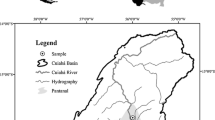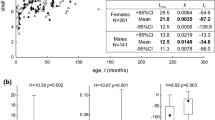Abstract
Our study focused on the Mediterranean species Hemimycale columella and Crella elegans, which have overlapping ecological distributions but contrasting population densities and resilience. We formulated the hypothesis that differential reproductive traits were the main cause underlying these ecological differences in the study area. The issues addressed were whether recruits compete for the substrate, either because their respective reproductive cycles overlap or/and larval performance differs between species, and whether a contrasting investment in reproduction contributed to explain their diverse densities. Both species were simultaneous hermaphrodites and incubated their larvae. The reproductive period was notably shorter in C. elegans than in H. columella, while investment in reproductive tissue was higher in individuals of H. columella than in C. elegans. In contrast, C. elegans larvae harbored larger amounts of lipids and yolk inclusions than H. columella larvae. Moreover, the former contained amazing collagen masses densely packed among their inner cells. H. columella is likely to produce a higher number of poorer equipped larvae while C. elegans seems to produce a lower number of more resistant, better fitted with energy reserves, and thus potentially more successful larvae. These reproductive patterns agree with a higher and stable density of C. elegans in the study site compared with a more variable abundance of H. columella.











Similar content being viewed by others
References
Baldacconi, R., C. Nonnis-Marzano, E. Gaino & G. Corriero, 2007. Sexual reproduction, larval development and release in Spongia officinalis L. (Porifera, Demospongiae) from the Apulian coast. Marine Biology 152(4): 969–979.
Blanquer, A. & M. J. Uriz, 2010. Population genetics at three spatial scales of a rare sponge living in fragmented habitats. BMC Evolutionary Biology 10: 13
Boury-Esnault, N. & B. Jamieson, 1999. Porifera. In Adiyodi, K. G. & R. G. Adiyodi (eds), Reproductive Biology of Invertebrates IX Progress in Male Gamete Ultrastructure and Phylogeny. Wiley, Chichester: 1–20.
Corriero, G., L. S. Liaci, C. N. Marzano & E. Gaino, 1998. Reproductive strategies of Mycale contarenii (Porifera : Demospongiae). Marine Biology 131(2): 319–327.
de Caralt, S., M. J. Uriz, A. V. Ereskovsky & R. H. Wijffels, 2007. Embryo development of Corticium candelabrum (Demospongiae : Homosclerophorida). Invertebrate Biology 126(3): 211–219.
De Vos, L., K. Rützler, N. Boury-Esnault, C. Donadey & J. Vacelet, 1991. Atlas of sponge morphology. Smithsonian Institution Press, Washington and London: 117.
Ereskovsky, A. V., 2000. Reproduction cycles and strategies of the cold-water sponges Halisarca dujardini (Demospongiae, Halisarcida), Myxilla incrustans and Iophon piceus (Demospongiae, Poecilosclerida) from the White Sea. Biological Bulletin 198(1): 77–87.
Ereskovsky, A. V., 2010. The Comparative Embryology of Sponges. Springer, Dordrecht, London.
Fell, P. E., 1974. Porifera. In Giese, A. & J. Pearse (eds), Reproduction of Marine Invertebrates: Acoelomate and Pseudocoelomate Metazoans. Academis Press, New York: 51–132.
Guardiola, M., J. Frotscher & M. J. Uriz, 2011. Genetic structure and temporal differentiation of cohorts of a recently introduced sponge (Paraleucilla magna) to the western Mediterranean. Hydrobiologia (in press).
Hooper, J. N. A. & R. W. M. Van Soest (eds), 2002. Systema Porifera: A Guide to the Classification of Sponges. Kluwer Academis/Plenum Publishers, New York.
Ilan, M., 1995. Reproductive Biology, Taxonomy, and Aspects of Chemical Ecology of Latrunculiidae (Porifera). Biological Bulletin 188: 306–312.
Ilan, M. & Y. Loya, 1990. Sexual reproduction and settlement of the coral reef sponge Chalinula sp. from the Red Sea. Marine Biology 105(1): 25–31.
Ilan, M., J. Gugel & R. W. M. Van Soest, 2004. Taxonomy, reproduction and ecology of new and known Red Sea sponges. Sarsia 89(6): 388–410.
Lepore, E., M. Sciscioli, L. Scalera-Liaci, G. Santarelli & E. Gaino, 2000. Sexual reproduction of Cinachyra tarentina (Porifera, Demospongiae). Italian Journal of Zoology 67: 153–158.
Lévi, C., 1973. Systématique de la classe des Demospongiaria (Démosponges). In Grassé, P. P., P. Brien, C. Lévi, M. Sarà, O. Tuzet & J. Vacelet (eds), Traité de Zoologie: Anatomie, systématique, biologie Spongiaires. Masson et Cie, Paris.
Leys, S. P. & A. V. Ereskovsky, 2006. Embryogenesis and larval differentiation in sponges. Canadian Journal of Zoology 84: 262–287.
Leys, S. P. & H. M. Reiswig, 1998. Transport pathways in the neotropical sponge Aplysina. Biological Bulletin 195: 30–42.
Mariani, S., M. J. Uriz & X. Turon, 2005. The dynamics of sponge larvae assemblages from northwestern Mediterranean nearshore bottoms. Journal of Plankton Research 27(3): 249–262.
Piscitelli, M., G. Corriero, E. Gaino & M.-J. Uriz, 2011. Reproductive cycles of the sympatric excavating sponges Cliona celata and Cliona viridis in the Mediterranean Sea. Invertebrate Biology 130(1): 1–10.
Reiswig, H. M., 1973. Population-dynamics of three Jamaican demospongiae. Bulletin of Marine Science 23(2): 191–226.
Reiswig, H. M., 1983. Porifera. In Adiyodi, K. G. & R. G. Adiyodi (eds), Reproductive Biology of Invertebrates II Spermatogenesis and Sperm function. Wiley, Chichester: 1–21.
Riesgo, A. & M. Maldonado, 2008. Differences in reproductive timing among sponges sharing habitat and thermal regime. Invertebrate Biology 127(4): 357–367.
Riesgo, A. & M. Maldonado, 2009. An unexpectedly sophisticated, V-shaped spermatozoon in Demospongiae (Porifera): reproductive and evolutionary implications. Biological Journal of the Linnean Society 97: 413–426.
Riesgo, A., C. Taylor & S. P. Leys, 2007. Reproduction in a carnivorous sponge: the significance of the absence of an aquiferous system to the sponge body plan. Evolution & Development 9(6): 618–631.
Rosell, D., 1993. Effects of reproduction in Cliona viridis (Hadromerida) on zooxanthellae. Scientia Marina 57: 405–413.
Scalera-Liaci, L. & M. Sciscioli, 1970. Il ciclo sessuale di Erylus discophorus (Schmidt) (Porifera: Tetractinellida). Rivista di Biologia 63: 255–270.
Simpson, T. L., 1984. Gamete, embryo, larval development. In Simpson, T. L. (ed.), The cell biology of sponge. Springer, Berlin: 341–413.
Uriz, M. J., M. Maldonado, X. Turon & R. Martí, 1998. How do reproductive output, larval behaviour, and recruitment contribute to adult spatial patterns in Mediterranean encrusting sponges? Marine Ecology Progress Series 167: 137–148.
Uriz, M. J., X. Turon & S. Mariani, 2008. Ultrastructure and dispersal potential of sponge larvae: tufted versus evenly ciliated parenchymellae. Marine Ecology 29: 280–297.
Vacelet, J. & N. Boury-Esnault, 1995. Carnivorous sponges. Nature 373(6512): 333–335.
Whalan, S., M. S. Johnson, E. Harvey & C. Battershill, 2005. Mode of reproduction, recruitment, and genetic subdivision in the brooding sponge Haliclona sp. Marine Biology 146(3): 425–433.
Whalan, S., C. Battershill & R. de Nys, 2007. Sexual reproduction of the brooding sponge Rhopaloeides odorabile. Coral Reefs 26(3): 655–663.
Woollacott, R. M. & R. L. Pinto, 1995. Flagellar basal apparatus and its utility in phylogenetic analyses of the Porifera. Journal of Morphology 226: 247–265.
Acknowledgments
We thank A. García and N. Cortadellas, from the Serveis científico-técnics, Universitat de Barcelona, for sample processing and assistance with electron microscopy, and A. Blanquer, S.de Caralt, E. Serrano, L. Navarro and A. Garí for help with fieldwork. We especially thank G. Giribet and A. Riesgo and two anonymous reviewers for their truly helpful comments on the manuscript. This study has been funded by CTM2007-66635-C02-01 and CTM2010-22218-C02-01 projects (Spanish Ministry of Science and Innovation) to MJU and a project-associated fellowship (FPI) to ARP-P.
Author information
Authors and Affiliations
Corresponding author
Additional information
Guest editors: M. Maldonado, X. Turon, M. A. Becerro & M. J. Uriz / Ancient animals, new challenges: developments in sponge research
Rights and permissions
About this article
Cite this article
Pérez-Porro, AR., González, J. & Uriz, M.J. Reproductive traits explain contrasting ecological features in sponges: the sympatric poecilosclerids Hemimycale columella and Crella elegans as examples. Hydrobiologia 687, 315–330 (2012). https://doi.org/10.1007/s10750-011-0919-6
Received:
Accepted:
Published:
Issue Date:
DOI: https://doi.org/10.1007/s10750-011-0919-6




